Pharma Nord has spent more than 20 years documenting the absorbability, effectiveness, and safety of the product Bio-Quinone Q10. But many Q10 products are currently sold without any documentation which may give the user assurance of an effect. In the wake of this a number of claims has emerged about what kind of Q10 is best. A team of U.S. Researchers has reviewed and weeded out the false claims. What remains are the facts about the effect and use of Q10.
 Unprocessed Q10 is poorly absorbed
Unprocessed Q10 is poorly absorbed
Optimum absorbability has been the keyword in the development of Bio-Quinone Q10, and this is documented in approx. 40 scientific studies.
One of the biggest challenges associated with Q10 as a supplement is that the substance generally is not readily absorbed by the body. Q10 in other words, has a low bioavailability. The Q10 molecule is a relatively large molecule and this is the main reason for its poor absorbtion in the body and as a result of its molecular structure, it is fat soluble.
Slowly release into the blood
Q10 is absorbed in the intestinal wall along with fat and is then transported by the lymph vessels to the subclavian vein, where it emptied into the venous blood. This slow mode of transport results in a maximum concentration of Q10 in the blood 6-8 hours after ingestion. Therefore, it is preferable to take Q10 with breakfast or perhaps lunch. If you take more than 1 capsule daily, the effect is larger by spreading the dose throughout the day - eg. one capsule at breakfast and one capsule at lunch time - rather than taking the daily dosage at once.
Crystals are not absorbed
A Bio-Quinone Q10 capsule contains a special oil matrix in which the substance Q10 is in a molecular form. The starting point for all products is the Q10 raw material consisting of crystals, which in practice are not absorbed by the body. Q10 must be dissolved into single Q10 molecules before they can be absorbed. Less than 1% of Q10 is absorbed from products solely consisting of crystalline Q10, typically tablet products and hard capsules using unprocessed Q10 crystals. The crystals may be dissolved by using a special oil mixture, and a subsequent heating method, thereby, releasing Q10 into single molecules, which provides a quick and good absorption with oil.
Q10 always fat-soluble
A marketing strategy has gone on to claim that it is better to make Q10 water soluble, but neither a change to the Q10 molecule or placement of the fat-soluble Q10 molecules in liposomes (small spheres with an outer fatty membrane and an inner aqueous membrane) or linking Q10 to micelles (small spheres with a fatty core and a water-loving surface) or attaching nano-particles to Q10 will make the Q10 molecule more water soluble.
If you try, you just end up with an even bigger Q10 molecule complex, but no increased bioavailability and the Q10 molecule will still predominantly be fat soluble. If you choose to go the opposite way and make the molecule smaller, this will surely make the molecule more water soluble and more absorbable, but such a reduced molecule will no longer be Q10, but would be reduced to Q9 or Q8 which is of no value to humans.
Most documentation on ubiquinone
 Q10 is found in two forms. An oxidized form called ubiquinone as well as a reduced form called ubiquinol. Ubiquinol is also marketed as active Q10 although ubiquinol isn't more active than ubiquinone. The form of Q10 we produce in our cells, is the oxidized ubiquinone. Also Q10 from our food is predominantly the oxidized form. When we absorb the oxidized ubiquinone from the intestine it is automatically converted to reduced ubiquinol. In the blood and lymphatic system 90-95% of Q10 is in the form of ubiquinol. In the cells' energy-producing mitochondria Q10 alternate continuously between these two forms, a feature that is crucial for Q10s effects in the body.
Q10 is found in two forms. An oxidized form called ubiquinone as well as a reduced form called ubiquinol. Ubiquinol is also marketed as active Q10 although ubiquinol isn't more active than ubiquinone. The form of Q10 we produce in our cells, is the oxidized ubiquinone. Also Q10 from our food is predominantly the oxidized form. When we absorb the oxidized ubiquinone from the intestine it is automatically converted to reduced ubiquinol. In the blood and lymphatic system 90-95% of Q10 is in the form of ubiquinol. In the cells' energy-producing mitochondria Q10 alternate continuously between these two forms, a feature that is crucial for Q10s effects in the body.
Therefore, it is of minor importance what form of Q10 you consume, your body will still convert the oxidized ubiquinone to reduced ubiquinol. To date, almost all documentation on efficacy and safety are done with the oxidized form, ubiquinone.
- Ubiquinone = oxidized Q10
- Ubiquinol = reduced Q10
Scientific research
All Pharma Nord's products are based on thorough scientific research. Pharma Nord's own research department is continuously working to be fully abreast of the latest knowledge about health and nutrition. This requires a careful monitoring of the research progress and also planning and conduct of investigations of Pharma Nord's products in cooperation with the leading Q10 experts in the world.
One of the latest studies done with Pharma Nord's Q10 was the Q-Symbio study. Professor Sven Aage Mortensen from Rigshospitalet in Copenhagen and his colleagues in EU and Asia presented the results of the Q-symbio study for the first time at a congress of cardiologists in Lisbon, Portugal, 23 - 28 May 2013.
420 patients from nine different countries was included in the Q-symbio study who examined a group of persons with low levels of Q10.
The active treatment consisted of a soft gelatin capsule with 100 mg of Q10 three times a day for two years. The study wanted to show how well those who got Q10 performed compared to those who had to do without.
Last year we saw another study with healthy elderly in the so-called KiSel-10 study where Dr. Urban Alehagen and his team used the same Pharma Nord Q10 with the selenium product SelenoPrecise – and with similar results.
Why Q10 from Pharma Nord?
Researchers prefer Pharma Nord Q10 because it has documentation from more than 90 scientific studies and also documentation for high bioavailability and safety. It is manufactured under Danish pharmaceutical control and is the official reference product for ICQA (International Coenzyme Q10 Association).
Pharma Nord has also Q10 registered as a drug.
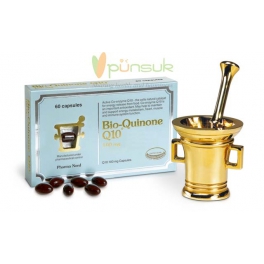 ดูรูปขนาดจริง
ดูรูปขนาดจริง 


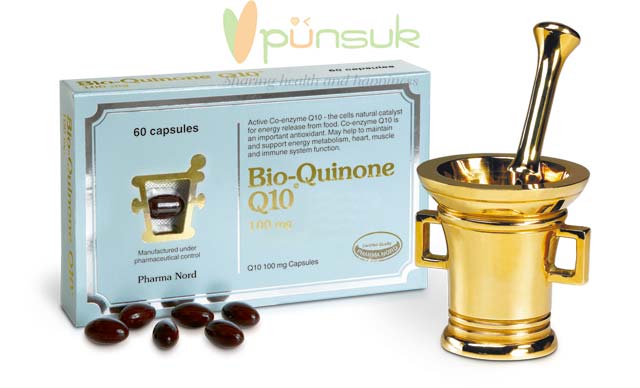
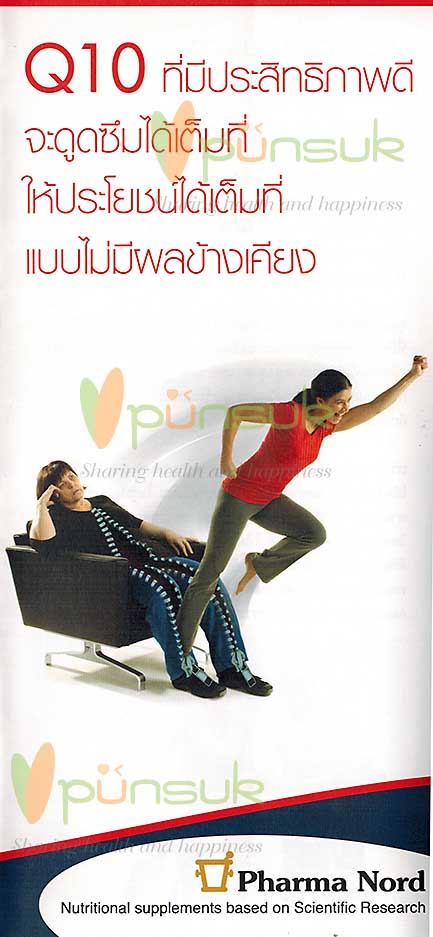
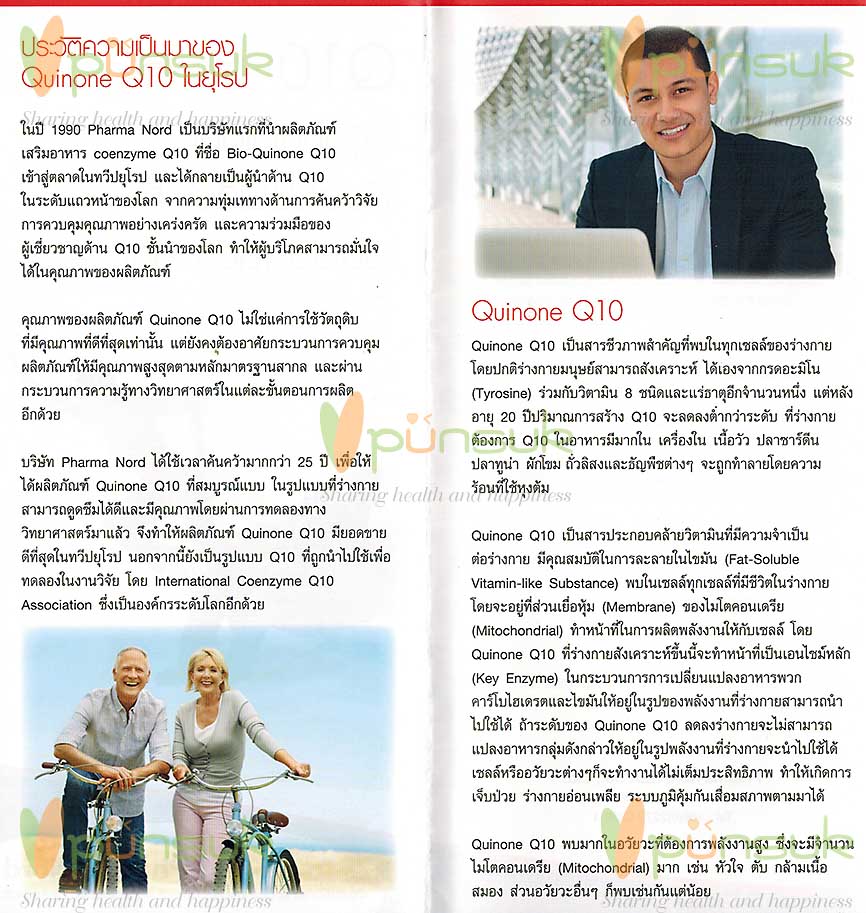
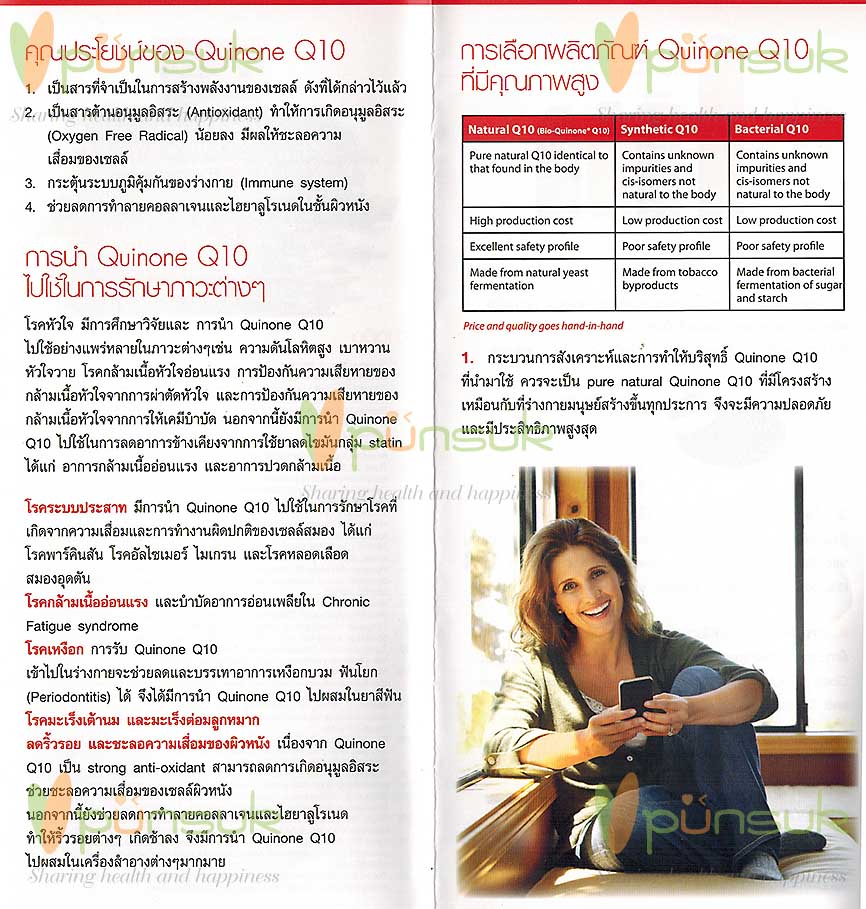
.jpg)











 Unprocessed Q10 is poorly absorbed
Unprocessed Q10 is poorly absorbed Q10 is found in two forms. An oxidized form called ubiquinone as well as a reduced form called ubiquinol. Ubiquinol is also marketed as active Q10 although ubiquinol isn't more active than ubiquinone. The form of Q10 we produce in our cells, is the oxidized ubiquinone. Also Q10 from our food is predominantly the oxidized form. When we absorb the oxidized ubiquinone from the intestine it is automatically converted to reduced ubiquinol. In the blood and lymphatic system 90-95% of Q10 is in the form of ubiquinol. In the cells' energy-producing mitochondria Q10 alternate continuously between these two forms, a feature that is crucial for Q10s effects in the body.
Q10 is found in two forms. An oxidized form called ubiquinone as well as a reduced form called ubiquinol. Ubiquinol is also marketed as active Q10 although ubiquinol isn't more active than ubiquinone. The form of Q10 we produce in our cells, is the oxidized ubiquinone. Also Q10 from our food is predominantly the oxidized form. When we absorb the oxidized ubiquinone from the intestine it is automatically converted to reduced ubiquinol. In the blood and lymphatic system 90-95% of Q10 is in the form of ubiquinol. In the cells' energy-producing mitochondria Q10 alternate continuously between these two forms, a feature that is crucial for Q10s effects in the body.


























